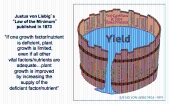So I've been doing this for a few months now. My system is a 6" rocket mass heater in an aquaponics greenhouse. My heater is in the greenhouse to help keep it warm, the exhaust system is a series of brick channels under one of my raft tables so it heats the water and then my final exhaust goes into a T. One side of the T exits the greenhouse, the other points in and I have a 25' piece of 6" flexible tubing I can use to direct the CO2 where ever I need it to go.
Some thoughts. First, not sure what folks are talking about with the amount of CO2 produced. Burning 1 lb of wood produces around 1.8 lbs of CO2. I know that might seem counterintuitive, but it's because of all the oxygen brought in. 1 lb of CO2 is roughly 8.5 cf. If you want to calculate parts per million (ppm) to decide how much wood to burn to get the right CO2 ppm, you need to figure out the volume of your greenhouse. My greenhouse is 10' x 24' x 8' or 1920 cf. If normal CO2 concentration is around 400 ppm and I want 1500 ppm (a good number to boost plant growth), the way I calculate it is turn ppm into a decimal (1500/1,000,000 = .0015) then multiply that by my total volume in the greenhouse and that gives the number of cubic feet of CO2 I need. .0015 x 1920 cf (the volume of my greenhouse) comes out to just under 3 cf, which means burning a pound and a half of wood will give me enough CO2 to get over 1500 ppm (there's already CO2 in the air). Given that the plants are using some and there's always air loss, I aim for 1500-2000. Some day I'd like to buy a CO2 meter, but they're fairly expensive and it hasn't seemed worth it yet.
There are a few things to think about before you try to boost CO2 with your rmh exhaust. First, CO2 is heavier than normal air, so you need a way to get the exhaust to the right place and let it "fall down" to a degree and circulate. A second big question for your system is the temperature of your exhaust. I have about 32' of duct for a 6" system with four u-turns, so my exhaust exits the system never hotter than 80 degrees or so. But if you're air is coming out really hot, you'll need to be careful about how you pump it near your plants or you'll dry them out/burn them. Third, your burn has to be incredibly clean. Every once in a while I have some wood that was wetter than I thought or some pine that is really oily, and the burn is smoky. I never pump the exhaust into my greenhouse until I'm a good way into burning a load of wood and I've seen that the exhaust is as clear as can be. Last, for CO2 to have the most benefits for plants, the temperature, humidity and light levels all need to be within a good range, along with good air circulation. Poking around on the internet I found a really detailed guide to CO2 enrichment, if you're interested let me know. Basically, temps around 80, humidity under 40%, bright light and good circulation and then, CO2 enrichment helps a bunch.
I haven't done anything like clear experimentation to test the effects yet, but I have been playing with blowing in CO2 during the day (doing it at night doesn't help because CO2 is all about boosting photosynthesis and plants don't photosynthesize at night

and it's seeming like the results are positive compared to my estimations of earlier growth. One last bummer about this system for generating CO2, you end up heating your greenhouse during the day. Out here in Northern California, it's already 75 degrees, so I'm working hard to get rid of heat. Burning my heater in the middle of the summer to get CO2 doesn't sound fun, but I can burn 1-2 lbs of wood in 20 minutes or so, so it doesn't take long to generate the CO2 you'll need.
One other huge reason to think about CO2 in a greenhouse, pest control. There's not a lot of research or guidance on this, but if you get CO2 up to 10,000 ppm, a level way past deadly for humans, leave it there for somewhere between 10-50 minutes, it also kills insects. It will kill any beneficial insects you have in the greenhouse, but it kills aphids, mites, anything. I've only done some limited testing with this and so far the results have been less than amazing. I did a few tests of burning 3-4 lbs of wood (to make sure I had enough CO2) in my greenhouse with it all sealed, left it for a few hours and came back later to check and it had almost no effect. I tried again with my flex tubing, blowing the CO2 almost directly onto the plants, again, almost no effect.
I did an experiment of taking a plant that was covered with aphids, putting it in an empty garbage bag, then filling the garbage bag with exhaust from my system - pretty much pure CO2. I checked 30 minutes later and 90% of the aphids were dead, but a bunch were just sleepy/groggy and started moving around after a few minutes.
I've seen this documented quite a few times (gotta love those pot growers trying out everything to boost production

and I've got an aquaponics guru friend who swears by it, so I'm going to keep playing with it. I'm gonna try a few more test runs with infested plants in a garbage bag, see if I can figure out the time frame that does the trick. Then, my next idea is to put a small "tent" over one of my aquaponics rafts and fill that with CO2 and try that out. Aphids are a major problem for all the leafy greens I produce, so figuring this out is a significant priority.
I'm always curious to hear tricks folks use in their greenhouses and how rmh's fit into that. Let us know what you're thinking and trying - Rick
The box in the picture is at the end of my table where the exhaust exits. There's a fan in the bottom of the box that sucks the air through the table and provides draft for the rmh (blasphemy, I know, but it works great so far) and lets me direct the air where I want it to go. I have a cap for the T and I just cover whichever side I want blocked and let the air flow out the other.































 1
1




 and it's seeming like the results are positive compared to my estimations of earlier growth. One last bummer about this system for generating CO2, you end up heating your greenhouse during the day. Out here in Northern California, it's already 75 degrees, so I'm working hard to get rid of heat. Burning my heater in the middle of the summer to get CO2 doesn't sound fun, but I can burn 1-2 lbs of wood in 20 minutes or so, so it doesn't take long to generate the CO2 you'll need.
and it's seeming like the results are positive compared to my estimations of earlier growth. One last bummer about this system for generating CO2, you end up heating your greenhouse during the day. Out here in Northern California, it's already 75 degrees, so I'm working hard to get rid of heat. Burning my heater in the middle of the summer to get CO2 doesn't sound fun, but I can burn 1-2 lbs of wood in 20 minutes or so, so it doesn't take long to generate the CO2 you'll need.
 and I've got an aquaponics guru friend who swears by it, so I'm going to keep playing with it. I'm gonna try a few more test runs with infested plants in a garbage bag, see if I can figure out the time frame that does the trick. Then, my next idea is to put a small "tent" over one of my aquaponics rafts and fill that with CO2 and try that out. Aphids are a major problem for all the leafy greens I produce, so figuring this out is a significant priority.
and I've got an aquaponics guru friend who swears by it, so I'm going to keep playing with it. I'm gonna try a few more test runs with infested plants in a garbage bag, see if I can figure out the time frame that does the trick. Then, my next idea is to put a small "tent" over one of my aquaponics rafts and fill that with CO2 and try that out. Aphids are a major problem for all the leafy greens I produce, so figuring this out is a significant priority.
 1
1





















